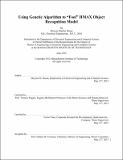Using genetic algorithm to "fool" HMAX object recognition model
Author(s)
Hasan, Maysun Mazhar
DownloadFull printable version (2.719Mb)
Alternative title
Using genetic algorithm to "fool" Hierarchical Model and X object recognition model
Other Contributors
Massachusetts Institute of Technology. Dept. of Electrical Engineering and Computer Science.
Advisor
Tomaso Poggio and Victor Chan.
Terms of use
Metadata
Show full item recordAbstract
HMAX ("Hierarchical Model and X") system is among the best machine vision approaches developed today, in many object recognition tasks [1]. HMAX decomposes an image into features which are passed to a classifier. These features each capture information about a small section of the input image but might not have information about the overall structure of the image if there is not a significant number of overlapping features. Therefore it can produce a false-positive if two images from two different classes having sufficiently similar features profile but completely different structures. To demonstrate the problem this thesis aimed to show that the features of a given subject are not unique because they lack geometric information. Genetic algorithm (GA) was used to create an image with a similar feature profile as a subject but which clearly does not belong to the subject. Using GA, random pixel images converged to an image whose feature profile has a small Euclidian distance from a target profile. This generated GA image does not resemble the target image but has a similar profile which successfully fooled the classifier in most cases. This implies that the "binding problem" is a major issue in a HMAX model of the size tested. Furthermore, methods of improving the system were investigated.
Description
Thesis (M. Eng.)--Massachusetts Institute of Technology, Dept. of Electrical Engineering and Computer Science, 2012. Cataloged from PDF version of thesis. Includes bibliographical references (p. 48-49).
Date issued
2012Department
Massachusetts Institute of Technology. Department of Electrical Engineering and Computer SciencePublisher
Massachusetts Institute of Technology
Keywords
Electrical Engineering and Computer Science.